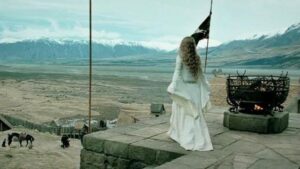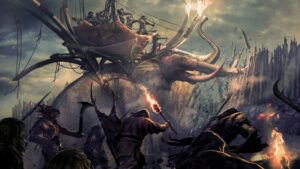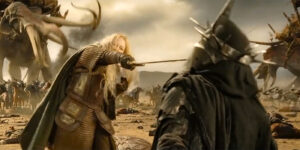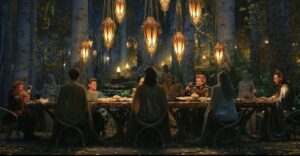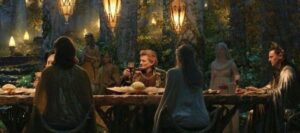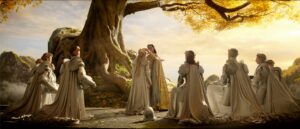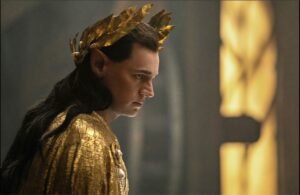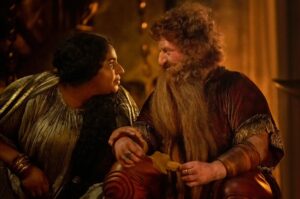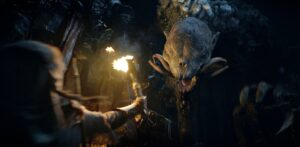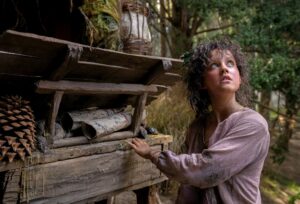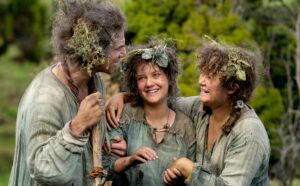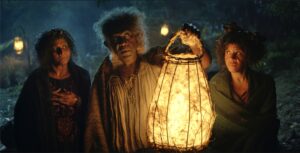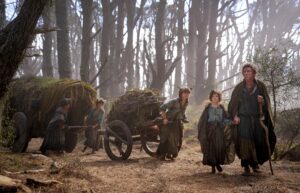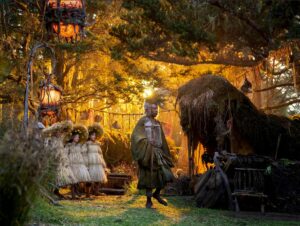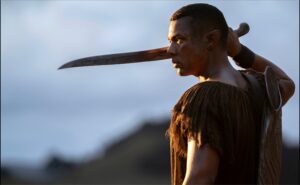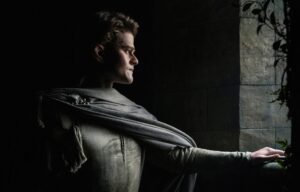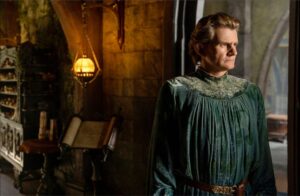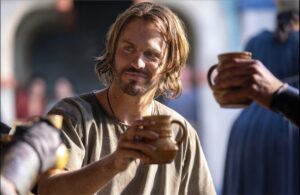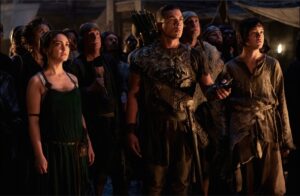“The past is dead. We either move forward, or we die with it.”
So says Elendil in the new full-length trailer for The Lord Of The Rings: The Rings Of Power, but for Amazon’s sake, they had better hope the past still has a little bit of life left in it, because if this billion-dollar venture of theirs is going to prove commercially successful, it needs to convince casual fans of J.R.R. Tolkien’s works and people who have never read his writing or watched the film adaptations of his novels that they could care enough about the events of Middle-earth’s ancient history to sit down and watch roughly eight hours of streaming television based on the Appendices to The Lord Of The Rings. I hope this trailer does the trick, because I don’t know if we’re getting another one before the series premieres in early September.
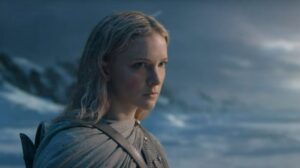
The strategy at play in this new trailer is very simple. From the opening shot of Númenor’s coastal capital city viewed through a ravine speckled with seabirds and monuments honoring long-dead kings to the final shot of Sadoc Burrows leading a small group of scruffy yet intrepid Harfoots far afield over rolling green hills in search of a new home, the trailer aims to shock-and-awe its potential viewers with the kind of spectacular visuals that streaming services often struggle to deliver consistently…and very rarely in the first season of a new show. It’s what Middle-earth deserves, of course, but it’s also what will get people talking about The Rings Of Power to their friends and family, because you don’t need to have read the books or seen the movies to know that the show looks incredible.
For anyone wondering why these trailers haven’t given away many story details yet, I think you have your answer – it’s because Amazon believes that such details not only wouldn’t be relevant to anyone who hasn’t read The Lord Of The Rings (and more specifically its Appendices, further limiting the amount of people for whom the content of the story itself would convince them to watch), but could potentially give casual viewers the impression that the show is overly convoluted and inaccessible, which is definitely not what Amazon wants. That’s just my amateur analysis, of course, but in my mind it makes sense to assume you’re losing viewers every time you throw decontextualized pieces of information and unfamiliar names at them in a trailer.
If you’ve read the Appendices to The Lord Of The Rings and are reading this post, I’m going to assume you’re already aware that The Rings Of Power is set during the Second Age and depicts Middle-earth in its heyday – the way it would have appeared before countless wars reduced its fair cities and proud towers to rubble; before Sauron and his orcs pillaged Ost-in-Edhil, before a Balrog stalked the hallways of Khazad-dûm, before the seas rose to swallow Númenor whole, before the Elves allowed the forest to reclaim their homes in Lindon. The question now is whether more casual fans will recognize any of these locations as the same ones they saw ruined or abandoned by the time of Peter Jackson’s Lord Of The Rings trilogy, or whether they’ll be sufficiently wowed that it won’t matter if they do or not.
Who, indeed, could be unmoved by the sight of Khazad-dûm in the days before its fall, “not darksome but full of light and splendour” as Gimli so eloquently described it in The Fellowship Of The Ring? To be honest, Tolkien left so much unsaid regarding Khazad-dûm that in this case, even the books won’t adequately prepare you for what The Rings Of Power has in store – in a single screenshot from the trailer, we’re instantly transported back three-thousand years to a time when “the light of sun and star and moon” showered down upon the Dwarven city through many vents and windows in the high ceilings and, by means of mirrors mounted on walls and pillars, zig-zagged away into the mines and cavernous places deep beneath the Misty Mountains – nourishing not only the Dwarves, but an entire underground ecosystem including a forest and a hanging garden.
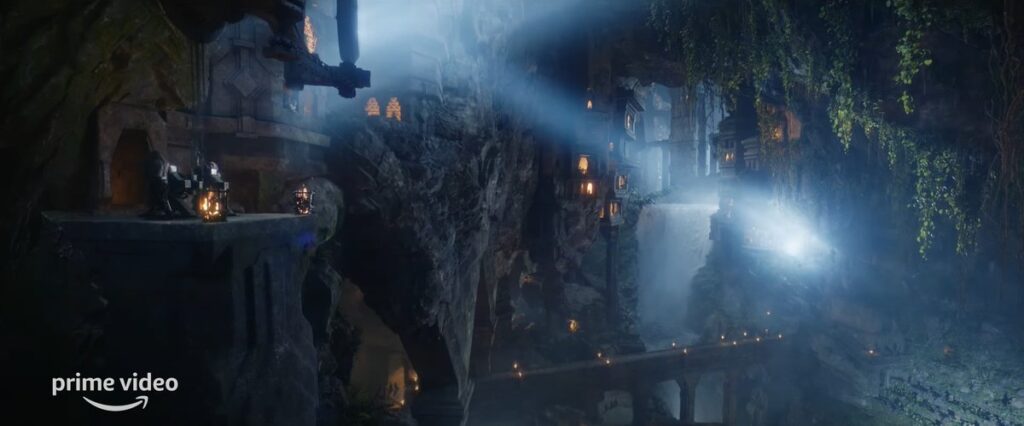
That’s just one example of a location and an entire archaic culture constructed in reverse by The Rings Of Power‘s Emmy-award worthy team of concept artists (headed up by the legendary John Howe), production designers, prop-makers, weapon-smiths, armorers, costume designers, hair and makeup artists, and God (or possibly Jeff Bezos) only knows how many others who must have been involved in helping restore Middle-earth to its former glory with all the delicacy and dedication of archaeologists on a dig-site. I could go on for hours, quite frankly, but I think you get the gist: The Rings Of Power is visually stunning and aesthetically pleasing, and that’s likely to be the show’s main selling-point until Amazon feels they can afford to push the story and characters equally as hard (the way Netflix eventually did with The Witcher).
And that’s not to say they haven’t been marketing the story and characters at all; just that it hasn’t been their top priority. At least this new trailer features actual dialogue from Galadriel, Marigold Brandyfoot, Elrond, Gil-galad, Arondir, Elendil, and Durin IV (this is the first time we’re hearing most of these characters speak, as a matter of fact, and while we’re on the topic I have to mention that Robert Aramayo’s Elrond in particular sounds just right – I still don’t know how I feel about his short tousled hair, but he’s won me over with his voice, poise, and mannerisms). There’s also a much stronger focus on the Elves, Dwarves, and Humans, as opposed to the Harfoot-centric first teaser narrated by Elanor Brandyfoot.
Regarding the Elves, what stood out to most fans were all the flashbacks to events in the First Age – events recounted only briefly in the Appendices to The Lord Of The Rings. Amazon doesn’t have the rights to J.R.R. Tolkien’s posthumously-published compendium of First Age myths and legends, The Silmarillion, which would have allowed them to go into greater detail on certain subjects like the Years of the Trees, Fëanor, the Silmarils, and the War of Wrath, so I’m still a little wary of getting my hopes up for things I don’t think The Rings Of Power can actually show us, but I can’t deny that every time the trailers slip in a sneaky reference to something covered extensively in The Silmarillion it makes me wish they had those rights so they could show us what they’re just vaguely referring to.
I suspect the Tolkien Estate is clinging onto those rights because they know better than anyone that fans will always want to see more than Amazon is currently able to show, and that as demand for The Silmarillion grows, they can gradually drive up the price and force Amazon to fork over another $250 million before filming on season two gets underway. And The Silmarillion is only the beginning! Imagine what Amazon would be willing to pay for the rights to Unfinished Tales and its references to the mysterious Blue Wizards…
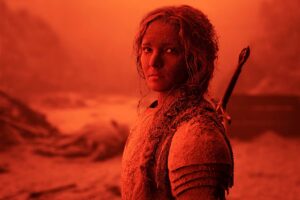
Anyway, what Amazon has been able to show us – even without needing to draw on The Silmarillion – is the same vista of Valinor under the light of the Two Trees that was first revealed to us in an image released almost one year ago, just from a slightly different angle. Later, when Elrond starts mansplaining to Galadriel that it’s time for her to “put up [her] sword” and relax because the enemy has been defeated, Galadriel’s simple yet chilling response – “you have not seen what I have seen” – is intercut with crimson-tinted images of Galadriel covered in ash and of bodies floating in deep water, meant to look like Amazon’s interpretation of the Sinking of Beleriand and the War of Wrath (not that Galadriel canonically played any part in that war, but I’ll let it slide because that never made sense to me anyway, sorry Tolkien).
We also catch a few more quick glimpses of what each of our Elven protagonists are up to in season one, from Galadriel fighting an ice-troll in the Forodwaith to a captive Arondir wrestling giant wolves in a pit (not entirely sure what that’s about, but I’m assuming the parallels to Finrod’s last fight are intentional?), as well as more Elven cities – including what looks like Ost-in-Edhil, where the Rings of Power will be forged. As a side-note, I’m not sure whether to be amused or frustrated that there’s been no mention of Rings (of Power, or otherwise) in any of the three teasers released. I guess season one is all one long, slow-burn backstory for why the Rings were made, but to not even foreshadow the Rings seems like a missed opportunity.
Well, there is one moment in the trailer that could be interpreted as backstory for the Rings – but it involves Durin IV, a semi-canonical character whom Tolkien probably only bothered naming because he needed to get the total number of Durins to seven. Durin IV probably lived near the end of the Second Age and never had anything to do with the creation or distribution of the Rings of Power, yet his ancestor Durin III was actually a close friend of the Ring-maker Celebrimbor and the only Dwarf-lord to whom Celebrimbor personally gifted one of the Seven Rings (according to the Dwarves)…so naturally, in the show, their roles have been swapped. Durin III is now a peripheral character (albeit played by Westworld‘s Peter Mullan, so he’s sure to be a scene-stealer), while Durin IV is the friend of Celebrimbor.
And it’s Durin IV whom we see holding aloft a chunk of raw mithril and proudly declaring “the beginning of a new era”, heavily implying that this is the first discovery of mithril in Khazad-dûm…which somehow feels like a more significant act of timeline-compression than I think it is. It doesn’t really affect anything; it just means that Celebrimbor must have had a different reason for settling in Eregion outside the west gates of Khazad-dûm besides wanting dibs on all mithril leaving the Dwarven kingdom. I just wonder what this is setting up for the future, because to my mind there’s only two options – one involves the creation of Galadriel’s Ring of Power, Nenya, and the other would necessitate moving the Fall of Khazad-dûm forward by roughly four-thousand years…and that’s what scares me about this change.
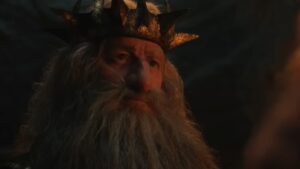
Just because the writers are already having to compress thousands of years of history into just five seasons of television doesn’t mean they should actively seek out opportunities to do more of that. Timeline-compression works best when it’s helping the story flow more smoothly to its destination (an example of this being Peter Jackson’s decision to do away with the seventeen-year long gap between Bilbo’s birthday party and Frodo leaving the Shire in The Fellowship Of The Ring), not when it’s forcing an epic story to shrink itself down to a more manageable size (like what’s at risk of happening in the case of Númenor).
I still firmly believe Amazon could have left the timeline just the way it was and gotten away with changing out the entire cast of human characters every season to emphasize the fear of mortality and decay prevalent among humans (and to some extent all the Free Peoples) throughout the Second Age, but I respect that, for whatever reason, they wanted a story where Isildur and Ar-Pharazôn are contemporaries of Celebrimbor, and they made the timeline work for them. We’ll have to wait until September to see if it pays off, but right now the sequences in Númenor certainly look compelling; particularly if you’re a fan of political intrigue tropes, as I am.
We see Ar-Pharazôn (still just Pharazôn at this point) riling up a colorfully-dressed crowd of Númenórean citizens with one of his speeches, presumably railing against the Elves and their leaders. Elendil’s daughter, Eärien, a non-canonical character described as politically-minded and opinionated, watches from the sidelines with an unreadable expression (it’s safe to assume that she’ll become one of Pharazôn’s allies, the “King’s Men”, in future seasons…and suffer the same terrible fate as all who join him in defying the Ban of the Valar). Tar-Míriel, the Queen Regent of Númenor, wanders through the streets of Armenelos with eyes fixed on the sky – from which particles of ash appear to be falling.
Elendil and Isildur, though not yet leaders of the Faithful, also appear – and The Rings Of Power foreshadows their future significance in the War of the Elves and Sauron by having them befriend and assist Galadriel after she washes up on the shores of Númenor with Halbrand, a probably non-canonical human character of indeterminate origins (I say probably because there’s a chance he’s the future Witch-king of Angmar or another of the nine Nazgûl, most of whose identities Tolkien never disclosed). Halbrand appears to part ways with Galadriel in Númenor – at one point in the trailer, he stands in the same large room where Ar-Pharazôn has been spotted in other images, and the two could very well become allies or rivals depending on what goes down between them there.

In the last ten seconds of the trailer, the focus returns to the Harfoots and their discovery of the mysterious Meteor Man – whose crash-landing we’ve now seen from various different angles, but this time we get the view from directly above…and there’s really no denying that, for a moment, as he’s lying there in a fetal position in the middle of a burning crater, he strongly resembles the Eye of Sauron as described by Tolkien in The Fellowship Of The Ring – “a single Eye….rimmed with fire, [that] was itself glazed, yellow as a cat’s, watchful and intent, and the black slit of its pupil opened on a pit, a window into nothing”. Coincidence? Deception? Or a hint that this conveniently amnesiac stranger is in fact Sauron, coming to interrupt Middle-earth’s long peace after centuries in hiding?
Based on their dialogue, Galadriel and Gil-galad at least seem fairly certain that Sauron was not defeated during the War of Wrath, and they warn of a darkness creeping back into the world from the deep woods and waters where it long lurked, as if answer to a summons. Gil-galad’s monologue on the subject accompanies footage of orcs marching in torchlit procession behind a tall, gaunt commander with long black hair and eyes like dark hollows in a pale face – not Sauron, but an original character supposedly named Adar, played by Game Of Thrones‘ Joseph Mawle and rumored to be a High Elf (possibly even one of Galadriel’s brothers) captured and corrupted by the darkness.
So as you can see, there’s actually a good amount of substance to this trailer, more than I think the majority of people will pick up on given that every story detail is intentionally presented without any context in an effort to avoid confusing people that could all too easily backfire if Amazon doesn’t provide viewers enough reasons to watch The Rings Of Power. The cinematic scope of the series and its top-notch production design will lure in folks who might otherwise scoff at fantasy, while its breathtaking CGI will earn high praise from those disillusioned by the shoddy work that Marvel Studios has been rushing out in the past few months (if I were Marvel, I’d be pushing back the release date of She-Hulk because it’s gonna be a bloodbath on Twitter when people start comparing screenshots from both shows).
Nostalgia for the Peter Jackson movies is also an important factor to take into consideration, although I could see it going both ways – on the one hand, there will be fans of the movies who are just happy to revisit Middle-earth even if it looks, sounds, and feels a little bit different…and on the other hand, you’ll have the violently angry stans spamming Amazon’s comments with hate because they can’t accept that Jackson’s interpretation of Middle-earth is not necessarily the definitive one.
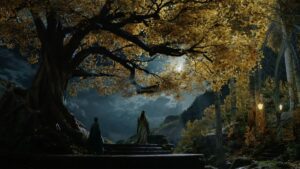
There’s obviously a lot of overlap between stans of Jackson’s films and fans of Tolkien’s writings, but at this point I think the latter are on average slightly more likely to tune into The Rings Of Power simply because there are a significant number of “purists” who didn’t like the movies and probably won’t end up enjoying the series either, but will either watch it for the sole purpose of complaining, or just to see what all the fuss is about. The upside to there so being so few new adaptations of Tolkien’s work over the past decade is that fans haven’t experienced anything resembling a “fatigue” yet, so we don’t not watch these things.
Will it be enough? I guess we’ll find out soon enough, but right now I want to know whether Amazon’s marketing strategy has been working for you – if so, I’d be interested to hear why, but if not, I’d be equally interested in hearing from my readers what Amazon could and should be doing to hook the hardcore fans, but even more importantly the casual viewers who only know The Rings Of Power through its trailers and promotional materials. Share your own thoughts, theories, and opinions, in the comments below!
Trailer Rating: 8.5/10



